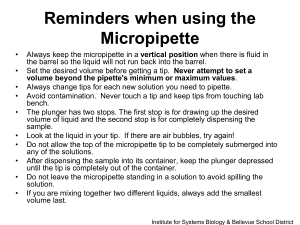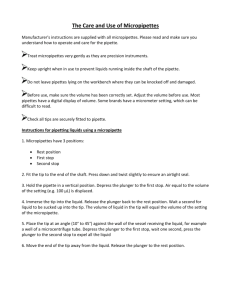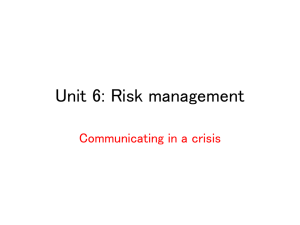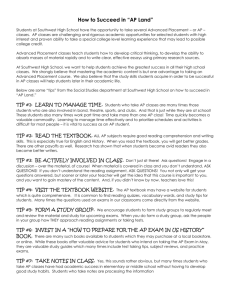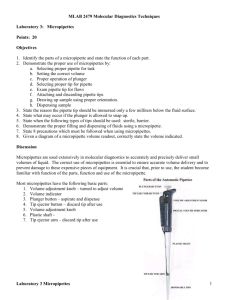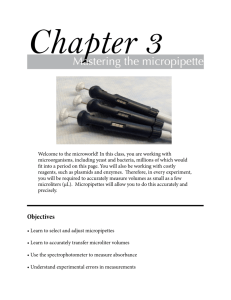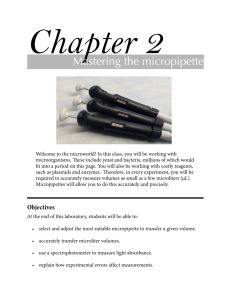Micropipetting Activity
advertisement
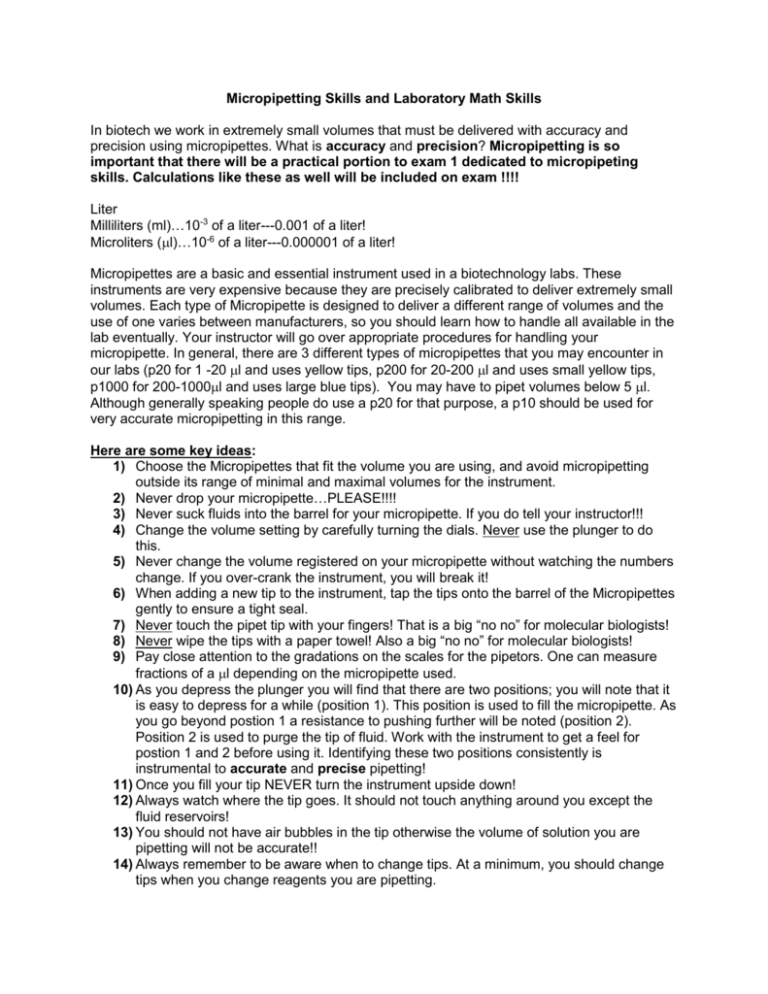
Micropipetting Skills and Laboratory Math Skills In biotech we work in extremely small volumes that must be delivered with accuracy and precision using micropipettes. What is accuracy and precision? Micropipetting is so important that there will be a practical portion to exam 1 dedicated to micropipeting skills. Calculations like these as well will be included on exam !!!! Liter Milliliters (ml)…10-3 of a liter---0.001 of a liter! Microliters (l)…10-6 of a liter---0.000001 of a liter! Micropipettes are a basic and essential instrument used in a biotechnology labs. These instruments are very expensive because they are precisely calibrated to deliver extremely small volumes. Each type of Micropipette is designed to deliver a different range of volumes and the use of one varies between manufacturers, so you should learn how to handle all available in the lab eventually. Your instructor will go over appropriate procedures for handling your micropipette. In general, there are 3 different types of micropipettes that you may encounter in our labs (p20 for 1 -20 l and uses yellow tips, p200 for 20-200 l and uses small yellow tips, p1000 for 200-1000l and uses large blue tips). You may have to pipet volumes below 5 l. Although generally speaking people do use a p20 for that purpose, a p10 should be used for very accurate micropipetting in this range. Here are some key ideas: 1) Choose the Micropipettes that fit the volume you are using, and avoid micropipetting outside its range of minimal and maximal volumes for the instrument. 2) Never drop your micropipette…PLEASE!!!! 3) Never suck fluids into the barrel for your micropipette. If you do tell your instructor!!! 4) Change the volume setting by carefully turning the dials. Never use the plunger to do this. 5) Never change the volume registered on your micropipette without watching the numbers change. If you over-crank the instrument, you will break it! 6) When adding a new tip to the instrument, tap the tips onto the barrel of the Micropipettes gently to ensure a tight seal. 7) Never touch the pipet tip with your fingers! That is a big “no no” for molecular biologists! 8) Never wipe the tips with a paper towel! Also a big “no no” for molecular biologists! 9) Pay close attention to the gradations on the scales for the pipetors. One can measure fractions of a l depending on the micropipette used. 10) As you depress the plunger you will find that there are two positions; you will note that it is easy to depress for a while (position 1). This position is used to fill the micropipette. As you go beyond postion 1 a resistance to pushing further will be noted (position 2). Position 2 is used to purge the tip of fluid. Work with the instrument to get a feel for postion 1 and 2 before using it. Identifying these two positions consistently is instrumental to accurate and precise pipetting! 11) Once you fill your tip NEVER turn the instrument upside down! 12) Always watch where the tip goes. It should not touch anything around you except the fluid reservoirs! 13) You should not have air bubbles in the tip otherwise the volume of solution you are pipetting will not be accurate!! 14) Always remember to be aware when to change tips. At a minimum, you should change tips when you change reagents you are pipetting. Use of the instruments: 1) Gently press the correct tip on the barrel without using your fingers and tap it to form a tight seal. Close the box after getting your tip!!! 2) Depress the plunger until just before it becomes hard to depress (position 1). 3) Then while watching the tip and with the plunger depressed, place just the end of the tip into the solution you are pipeting. Try not to drag the tip along the walls of the reservoir as it can drag down contaminants that might affect your experiment! 4) Slowly release the plunger and the fluid will fill the tip. There should be no air bubbles! 5) Pull the tip out and examine the tip. After a while you will know what 5 l or 1 l looks like vs 20 l or 200 l. 6) While watching the end of the tip, transfer the volume to the reservoir of interest and depress the plunger all the way down as far as you can go. This will purge the entire volume from the tip. Be sure to deliver the volume to the bottom of the reservoir if you are using one!! This is especially important when delivering and mixing very small volumes into a tube. 7) If you are adding two or more solutions together in a microfuge tube, you can gently mix by sucking the solution back and forth into the tip. But be sure not to introduce air and be sure to purge the tip afterwards so you don’t lose any of your solution. Discard your tip by pushing the outer white button on the top of the micropipette. Pipet the following volumes of water into three separate tubes, and observe the difference in volumes: 1000 l 200 l 20 l Using parafilm pipet the following volumes of water and examine the difference in size: 20 l 10 l 5 l 1 l Pipet 3.5 l of trypan dye into the 5 l drop and practice mixing the solutions together.
